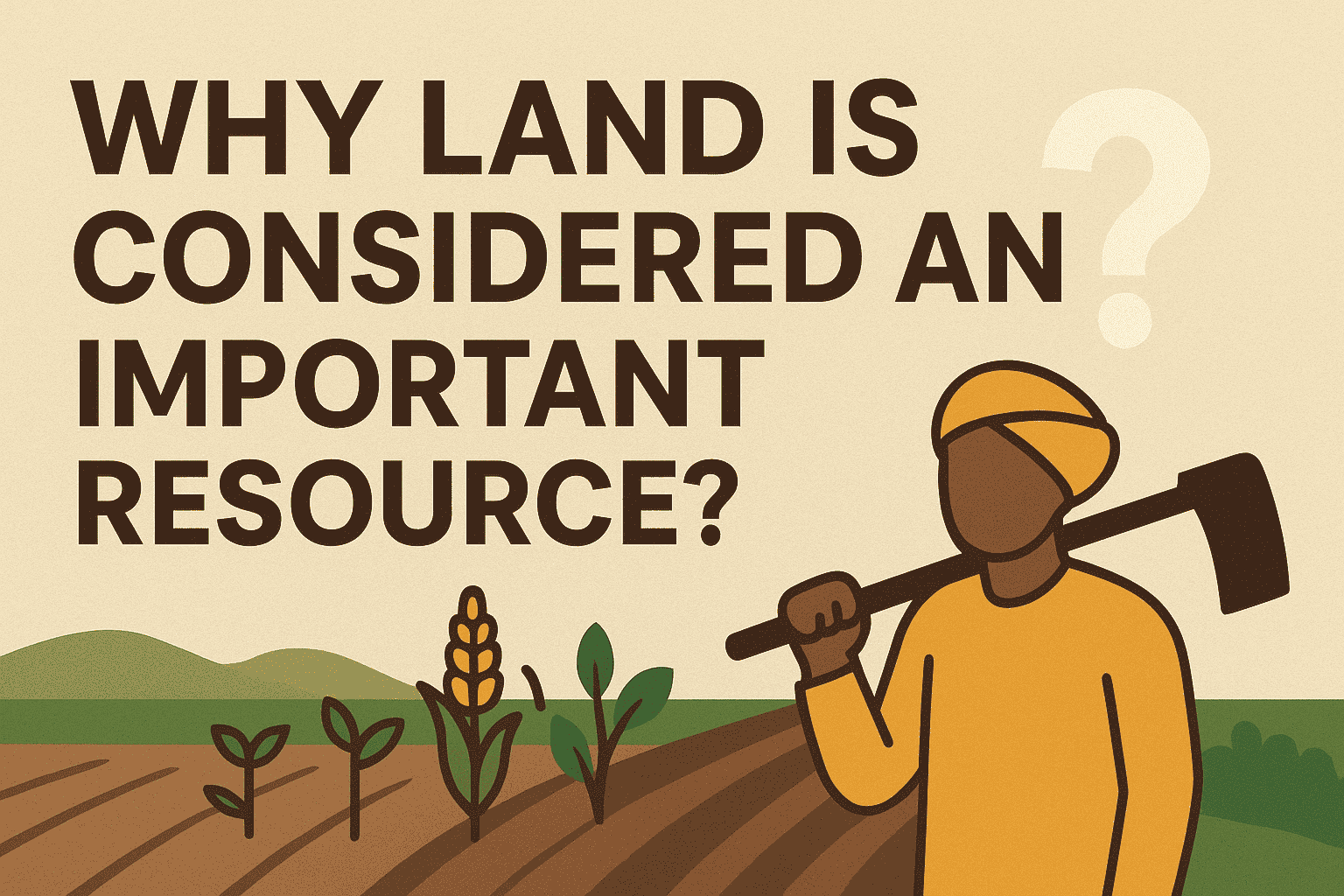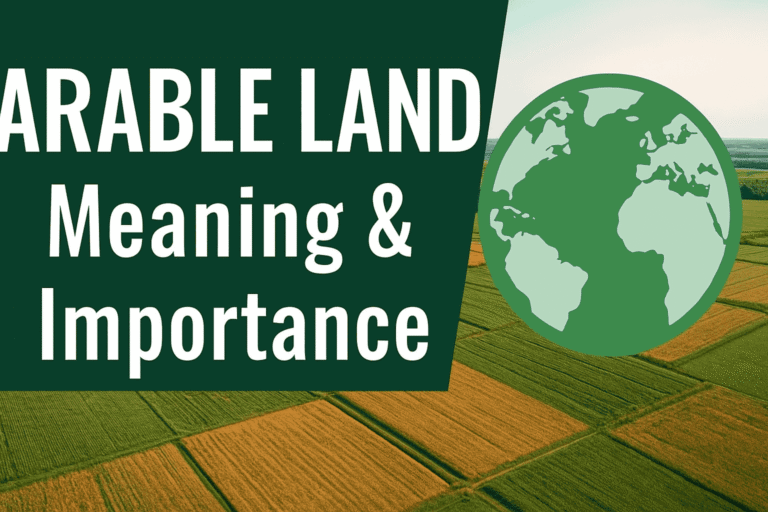Why Land is Considered an Important Resource? | Uses & Importance
Land is one of the most valuable and irreplaceable natural resources available to humankind. From providing food and shelter to supporting industries and biodiversity, land plays a central role in survival and development. Unlike water and air, land is finite—it cannot be expanded, making its proper utilization and conservation extremely important.
What is Land Resource?
In simple terms, land is the solid surface of the Earth that provides space and support for all human and natural activities. It includes agricultural fields, forests, cities, deserts, mountains, water bodies, and industrial zones.
Economists define land as a primary factor of production, alongside labor and capital, because industries, housing, agriculture, and trade cannot exist without it.
👉 Key Point: Land is non-renewable and must be used sustainably.
Historical Importance of Land
Land has been central to human history:
- Early civilizations (Indus Valley, Mesopotamia, Egypt) flourished on fertile lands near rivers.
- Land ownership determined power, wealth, and status in kingdoms and empires.
- Wars and conflicts were often fought to capture land and its resources.
- Even today, in rural India, land ownership reflects social prestige and security.
Why Land is Considered an Important Resource?
Here are the top reasons why land is one of the most important resources:
1. Foundation of Human Life
All human activities—residential, agricultural, industrial, and cultural—take place on land.
2. Food Security
Fertile land ensures agricultural production, which is essential for human survival.
3. Economic Growth
Land supports industries, factories, transport, and markets—driving national economies.
4. Ecological Balance
Forests and wetlands regulate climate, preserve biodiversity, and prevent soil erosion.
5. Cultural & Social Identity
Land ownership symbolizes wealth, heritage, and community belonging.
6. Natural Resources
Minerals, coal, oil, and groundwater come from land, fueling industries and energy needs.
7. Wealth & Investment
Real estate and agricultural land are major assets whose value appreciates over time.
Uses of Land Resources
Different uses of land include:
- Agriculture – Farming, horticulture, animal grazing.
- Residential – Housing, apartments, villages.
- Industrial – Factories, warehouses, IT parks.
- Forests – Timber, wildlife, ecological balance.
- Infrastructure – Roads, railways, airports.
- Recreation & Tourism – Resorts, monuments, natural parks.
Importance of Land in India
India, being an agrarian economy, depends heavily on land:
- 60% of India’s population relies on agriculture.
- 56% of total land is cultivable.
- 21% is covered by forests.
- Rapid urbanization and industrialization are creating pressure on limited land.
The government has launched digital land record systems like Bhulekh, AnyROR (Gujarat), Dharani (Telangana), and Banglarbhumi (West Bengal) to make land management transparent.
Global Challenges of Land
Worldwide, land faces issues such as:
- Deforestation in Amazon and Indonesia.
- Desertification in Africa’s Sahel region.
- Urban Sprawl in developed countries.
- Soil erosion due to unsustainable farming.
- Land disputes and wars in conflict zones.
According to the UN, 24 billion tons of fertile soil are lost annually.
Conservation of Land Resources
Since land is limited, proper conservation is necessary:
- Afforestation and reforestation
- Soil conservation (terrace farming, crop rotation, contour ploughing)
- Organic and sustainable agriculture
- Planned urbanization and smart cities
- Efficient water and land management policies
- Community awareness and education
Conclusion
Land is not just soil beneath our feet—it is the foundation of life, economy, culture, and nature. Without sustainable management, issues like deforestation, soil erosion, and land degradation could threaten survival.
Thus, land should be treated as a finite, valuable, and shared resource that must be conserved for future generations.
FAQs
Q1. Why is land called a natural resource?
Land is a natural resource because it occurs naturally, supports life, and provides materials for human use.
Q2. Why is land considered an important resource in geography?
Geography highlights land as important since it determines climate, vegetation, agriculture, and settlement patterns.
Q3. What are the main uses of land?
Agriculture, housing, industries, forests, transport, and tourism.
Q4. Why is agricultural land important?
Agricultural land provides food grains, fruits, vegetables, and livestock for human survival.
Q5. Why is land important for economic development?
Industries, mining, transport, and trade all depend on land availability.
Q6. How does land support ecological balance?
Forests, wetlands, and grasslands protect biodiversity, regulate temperature, and reduce carbon emissions.
Q7. What are land resources in India?
Agricultural fields, forests, grazing lands, deserts, riversides, and mountains.
Q8. What is the cultural importance of land?
Land ownership provides identity, heritage, and social security, especially in rural societies.
Q9. Why is land called a finite resource?
Land area cannot be expanded—it is fixed, making it limited and precious.
Q10. What are the challenges of land use in India?
Population growth, deforestation, soil erosion, urban expansion, and land disputes.
Q11. How is land related to biodiversity?
Land hosts forests, wetlands, grasslands, and wildlife, maintaining ecological balance.
Q12. What is the role of land in industry?
Industries need land for factories, raw material extraction, and infrastructure.
Q13. What is land degradation?
Land degradation is the decline of soil fertility due to erosion, pollution, or overuse.
Q14. How can we conserve land resources?
Afforestation, soil conservation, planned urbanization, and sustainable farming.
Q15. Why is land considered wealth?
Land retains and increases value over time, serving as an asset and investment.
Related Articles:
What is Bhulekh? A Complete Guide to India’s Digital Land Records System
Understanding the Land Record Ecosystem of Uttar Pradesh
J&K Land Records Information System- Check J&K Jamabandi Records
Land Records Information System in India | Digital Land Records







